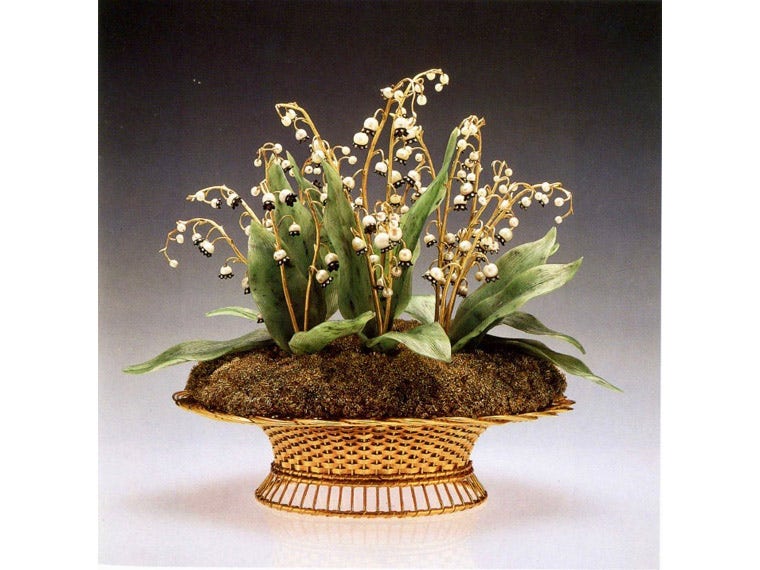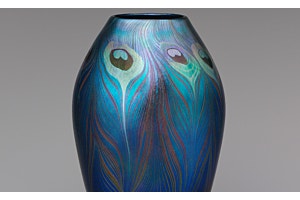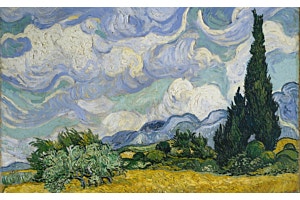
Born in St. Petersburg on May 30, 1846, Peter Carl Fabergé has been heralded as “the greatest craftsman in the age of craftsmen.” A master jeweler, he had a superb knowledge of historical styles and periods, past and present, whether his source was the glory of ancient Greece or the lavish court of Louis XV. A luxurious object from the House of Fabergé is invariably a creation of uncommon opulence, making each work instantly recognizable and highly original.

Imperial Lilies-of-the-Valley Basket. House of Carl Fabergé. August Wilhelm Holmström (1829–1903). Russian, St. Petersburg. Yellow and green gold, silver, nephrite, pearl, rose-cut diamond; 1896. Matilda Geddings Gray Foundation L.2011.66.56a, b
Fabergé was just 26 years old when he took over his father’s St. Petersburg jewelry store in 1872. With the help of his brother Agathon, he cultivated the patronage of Russia’s Romanov dynasty and the elite of Edwardian society. Fabergé’s studios produced a wide variety of objets d’art, including magnificent jewelry, clocks, cigarette cases, animal sculptures, boxes, and frames.
In 1885, Fabergé was named “Supplier by Special Appointment to the Imperial Court” of Czar Alexander III. His masterful work in gold, precious gems, lapidary carvings, and enamel made the House of Fabergé justly famous, with the ultimate achievement, of course, being his series of remarkable jeweled Easter eggs, such as the Imperial Napoleonic Egg (at top) and the Danish Palaces Egg (below).

Danish Palaces Egg. House of Carl Fabergé. Mikhail Evlampievich Perkhin (Russian, 1860–1903). Miniatures by Konstantin Yakovlevich Krijitski (died 1911). Russian, St. Petersburg. Green, rose, and quatre-couleur gold, guilloché enamel, star sapphire, cabochon emerald, rose-cut diamond nacre, crystal, crimson silk velvet; 1890. Matilda Geddings Gray Foundation L.2011.66.53a–c
Members of the European aristocracy, the Romanovs were connected by marriage to the crowned heads of Europe. Czar Alexander III’s son, Nicholas II, married German Princess Alix von Hesse in November 1894; she became Czarina Alexandra Feodorovna and bore Nicholas five children (see photo below). For these two Russian czars, Fabergé’s workshops produced extraordinary objects of fantasy and presentation pieces to give to heads of state, along with finely crafted items for the Imperial Family’s private use.
In 2008, The Met received a gift of 24 rare picture frames (an example, below) produced by the House of Fabergé. Each elegant tabletop frame is meticulously made and bears decorative finishes and details—such as beading, rosettes, and swags—in gold, silver, silver-gilt, guilloché enamel, ivory, or gemstones. Based on their markings, these precious luxury objects can be attributed to eight workmasters associated with the House of Fabergé in St. Petersburg and Moscow between 1896 and 1917.

Picture frame with signed photograph. House of Carl Fabergé. Karl Gustav Hjalmar Armfelt (Finn, working in Russia). Russian, St. Petersburg. Birchwood with silver-gilt mounts, 1908–17. Gift of Louise and David Braver, 2008 2008.652.2a, b
The Romanov’s alliances with the European elite made Fabergé an international figure; he also enjoyed notable support from the Danish and British royal families. Our popular Bee Earrings are based on a jeweled flower study (ca. 1900) in the British Royal Collection that features a diamond-studded bee perched atop a golden buttercup.
In particular, Fabergé brought the art of exquisite guilloché enamel to new heights of technical excellence. In his lifetime, he was considered the world's greatest master of this time-intensive technique, in which polychrome enamel is layered over circular, straight, or wave patterns engraved on metal. Our best-selling Guilloché Stripes Scarf highlights the lustrous hues of his enamel patterns.
Fans of Fabergé can admire a rotating selection of exquisite items from The Met collection and on loan from the Matilda Geddings Gray Foundation Collection (see featured image at top), in the Museum’s European Sculpture and Decorative Arts galleries as well as online. To lend a touch of regal elegance to your own wardrobe or home, shop our range of inspired Russian Imperial jewelry and accessories here.



